Krobia
Kullander & Nijssen, 1989
(formerly Aequidens)
Text and photos by Alf Stalsberg,
unless otherwise indicated.
CLICK ON ANY IMAGE TO ENLARGE IT
These fish are similar to Aequidens and were formerly placed in the genus Aequidens. But when Kullander did his revision of Cichlasoma in 1983, he placed these fish in the "'Aequidens' guianensis group".
At first glance you would guess these fish are Aequidens, and in most books you will find them under Aequidens. Only in new books, if they are updated, have the correct name. If you ask some people about Krobia, they would probably look surprised, because they don't know what you are talking about. So far you won't find many of these fish in stores either, the one that has been common on the market is the one we have called "Aequidens" guianensis, and we have also called the fish "Aequidens" itanyi, but this is also not correct.
I learned this when I was visiting Dr Kullander at the Natural History Museum in Stockholm. He showed me a lot of different jars with preserved fishes and he said here is "Aequidens' guianensis, here is more and here is "Aequidens" itanyi. I said, wait a minute, I thought that the name "itanyi" was not valid any longer? He said this is the correct "Aequidens" itanyi. At the time we were discussing this, he said that we have probably never had the real "Aequidens" itanyi in our tanks.
I could at first glance not see any differences when I compared the two jars, one with "Aequidens" guianensis and one with what Dr Kullander told me was "Aequidens" itanyi. But when he told me the differences I could easily see. There were of course, other differences, but this difference I, as an amateur, could easily see.
So now you are curious to hear what this difference is? Well, when you know it, it's quite easy. The stripe or band that the fish has along the side of the body, goes from just behind the eye and goes to the end of the dorsal fin (look at photo). On Krobia itanyi the band starts just behind the eye, but does not reach further than to the "shoulder spot". It does not goes all the way to the end of the dorsal.
Krobia guianensis
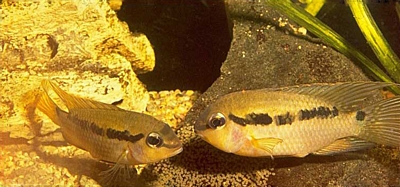 |
Krobia guianensis, a pair guarding eggs. |
Krobia guianensis is not difficult to keep, they spawn easy if the conditions are right. In my tanks they have been laying eggs like substrate brooders. I have heard, that they should lay eggs on leaves like the Bujurquina do, but I have not got this confirmed. I will when I get the fish back, try to get this confirmed.
I have been planning a trip to Surinam in September/October this year (1998) and I hope I will be able to study the fish in their natural environment. In the aquarium they behave just like Aequidens. They do not dig much, eat almost everything, and are very fond of earthworms, they eat so much they can hardly move, then lay on the bottom. But if you put in another earthworm, they will try to get that one too. The fish has been sold under many names, but I prefer to use the scientific name if I know it. The trade names are usually very confusing.
The following pictures are from a biotope in Surinam where we collected several fish and also Krobia guianensis, close to the road between Paramaribo and Zanderij the airport. And while we would like to have the fish in aquarium, others prefer them as food.
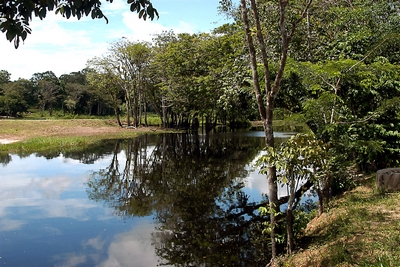 |
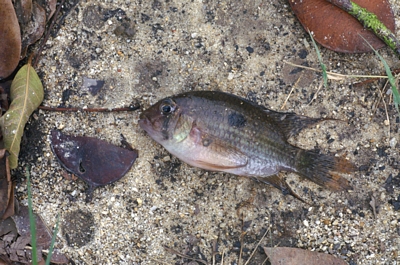 |
Here are some photos of Krobia guianensis and the biotope on the right side of the road from Zanderij airport and in to the capital city Paramaribo. |
Krobia potaroensis, (Eigenmann 1912)
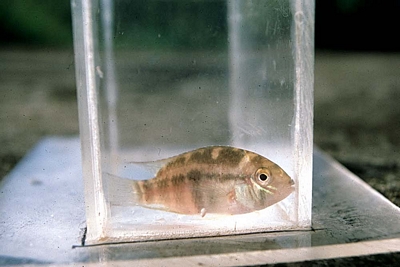
RIGHT: Krobia potaroensis in the aquarium.
It is now around 15 cm. |
LEFT: A young Krobia potaroensis in the photo tank after we collected it.
|
Krobia (Aequidens) potaroensis is not a common fish in your local fish shop and neither in the hobby. I'm not sure if I would have had the fish if I did not go to Guyana to collect them. It was up in Kamarang in a small tributary to Rio Mazaruni and the name of the small river was Kanawee Creek.
As you probably can see from the photos if you enlarge them, the water is rather clear, but it was rather chilly. If you had this temperature back home, you would probably say that the water was good, but here in South America it was rather cold, when it's about 21.7°C. When I had been in the water for about an hour, I had to get up and get warm, because I was shaking. pH was 6.5, the dH was 2 and kH was 1.
Krobia xinguensis
One rather new and undescribed Krobia is Krobia xinguensis. I saw it live some years ago and thought it was a new Aequidens, but they say that the name of the fish was Krobia and that it came from Brazil.
It a nice fish and it's not difficult to keep, a temperature around 25°C or a little more. They eat everything you give them, also easy to breed, and lay eggs on a flat stone. It might also spawn on dead leaves like the Bujurquina do, but I've so far not verified that.
You can feed the fry with newly hatched Artemia as first food and you can see that their bellies get red, so you can easily see that the fry eat. They can go in a community tank or a special tank together with fish with the same temperament or size. They don't destroy plants, but of course fish that are small enough to eat will probably end up as food.
Maybe not the strongest colored fish, but when it's in a good mood you can see the color the fish has on the cheek. This color can vary between orange to red. Nice fish, don't you think so too?
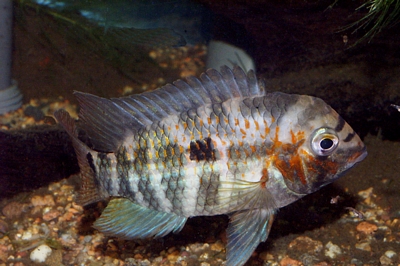 |
Krobia xinguensis. |
Well this was a little information about the genus Krobia, there is so far not many in this genus, but if you are interested in more information, and correct information, I will advise you to get a book named `THE CICHLIDS OF SURINAM', by Dr Sven O. Kullander & Dr Han Nijssen. Printed in Leiden, Holland by E.J. Brill. ISBN 90 04 09077 0
Let's also hope that the Krobia sp. xinguensis soon will be described too.
Cichlid Power,
Alf
DISCLAIMER: Statements made on this page are not herewith made available for the purpose of zoological nomenclature
under the International Code of Zoological Nomenclature.
Copyright 1995- Alf Stalsberg – Cichlid Power